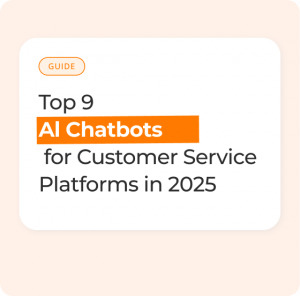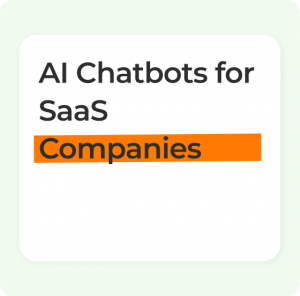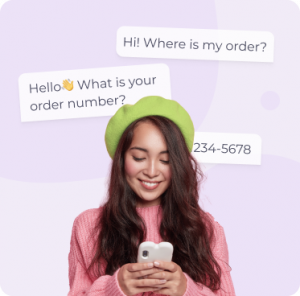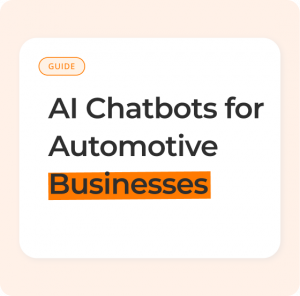AI Chatbot: Definition, Examples, and Best Practices
A chatbot is a software tool designed to simulate conversation with human users, usually online. Businesses use chatbots to answer questions, automate repetitive tasks, and deliver 24/7 service, making them essential for digital communication in 2025 and beyond.
What is a Chatbot?
A chatbot is a computer program that interacts with people through text or voice, providing automated responses to user inquiries. This technology has become critical for companies looking to enhance customer engagement and streamline support operations.
Generative AI-Powered Chatbots
Generative AI-powered chatbots are advanced virtual assistants that create responses on the fly using artificial intelligence and large language models. These bots can understand context, handle complex questions, and offer personalized answers, unlike traditional rule-based chatbots. Key capabilities include:
- Multi-turn, conversational dialogue
- Personalized responses based on user data
- Flexibility in handling unexpected requests
- Learning from previous interactions
Top Strategic Technology Trends for 2025: Agentic AI
Agentic AI refers to proactive, intelligent chatbots that don’t just react—they anticipate and act on user needs. In 2025, agentic AI will drive the next wave of automation by integrating deeply with workflows and making smart decisions for users. These trends include:
- Predictive personalization
- Automated scheduling and task execution
- Autonomous escalation of complex issues
- Seamless operation across multiple channels and platforms
The Value of Chatbots
Chatbots deliver significant value by improving response times, lowering support costs, and increasing customer satisfaction. They allow organizations to interact with users instantly, at any time, across a variety of channels. Benefits include:
- Always-on, 24/7 service
- Efficient handling of high inquiry volumes
- Real-time lead capture and qualification
- Consistent, branded communication
How Chatbots Work
Chatbots work by receiving a user’s message, processing it with rules or artificial intelligence, and generating a relevant response. The technology ranges from simple keyword-matching scripts to sophisticated AI systems that understand intent and context. The typical process includes:
- User submits a question or request
- The bot interprets the message
- Response is generated, either from a script or dynamically via AI
- Learning and improvement over time through machine learning
Chatbots versus AI Chatbots versus Virtual Agents
Chatbots, AI chatbots, and virtual agents are related but differ in capability and intelligence. A standard chatbot is rule-based, an AI chatbot leverages machine learning and natural language processing, while a virtual agent combines AI with advanced automation to solve complex business tasks. To clarify:
- Chatbot: Follows simple scripts and rules
- AI Chatbot: Understands intent, context, and adapts to conversation flow
- Virtual Agent: Acts as a digital colleague, handling multi-step processes and proactive actions
Common Chatbot Use Cases
Chatbots are used in a variety of ways to improve business operations and customer engagement. The most common use cases include marketing, sales, support, and internal automation.
Improve Customer Engagement and Brand Loyalty
Chatbots can increase engagement and boost loyalty by providing immediate, personalized attention to users. They offer:
- Welcoming returning customers by name
- Proactive updates and reminders
- Automated loyalty program enrollment and notifications
Reduce Costs and Boost Operational Efficiency
Businesses use chatbots to cut costs and run more efficiently by automating repetitive and low-value tasks. Efficiency gains include:
- Automated responses to common support questions
- Deflection of routine tickets to free human agents
- Scaling service to handle surges in demand
Generate Leads and Satisfy Customers
Chatbots help generate leads and enhance satisfaction by engaging website visitors and capturing their information in real time. Typical lead-generation activities include:
- Promptly collecting contact details
- Qualifying prospects with interactive questions
- Guiding users through purchasing or troubleshooting processes
- Gathering feedback for continuous improvement
Risks and Limitations of Chatbots
While chatbots offer many advantages, they also have risks and limitations such as misunderstanding queries or mishandling sensitive data. Organizations need to recognize these challenges and plan for human backup, compliance, and ongoing improvements. Limitations may involve:
- Inability to handle highly nuanced or emotional requests
- Potential data privacy and security risks
- Biases in AI-based responses
- Resource needs for regular maintenance and training
Best Practices and Tips for Selecting Chatbots
Choosing the right chatbot involves defining your business goals and ensuring the solution fits seamlessly into your existing tech stack. You should look for flexibility, integration, analytics, and strong data protection. Follow these tips:
- Set clear objectives and KPIs
- Test the AI’s contextual understanding and learning ability
- Check for integration with your CRM or helpdesk
- Verify security standards and data privacy compliance
- Ensure scalability and easy maintenance
- Pilot the bot and iterate based on user feedback
Benefits of AI Chatbots
AI chatbots offer a range of benefits, from delivering better service to reducing costs and unlocking actionable insights. They bring a measurable impact to customer experience and business efficiency. Here’s how:
1. Improve Customer Service
AI chatbots transform customer service by providing instant, consistent, and personalized responses any time of day. This leads to higher customer satisfaction and brand trust.
- 24/7 availability
- Personalized answers
- Consistent support quality
2. Save Costs
Automating repetitive inquiries with chatbots directly reduces labor costs and improves support scalability. This allows businesses to reinvest in growth areas instead of expanding headcount.
- Reduced staffing needs for routine tasks
- Efficiently handle spikes in demand
- Decreased churn through faster problem resolution
3. Enhance Customer Experience
AI chatbots improve user experience by offering seamless, conversational support across multiple channels. This creates a frictionless journey from start to finish.
- Omnichannel presence (web, mobile, social, voice)
- Proactive help and guidance
- Continuous learning from each interaction
4. Increased Efficiency and Productivity
Chatbots streamline workflows and boost productivity by handling routine queries, gathering information, and supporting staff with real-time information. This frees human agents for high-value work.
- Automated data collection and form filling
- Agent assistance with instant answer suggestions
- Routine task automation (e.g., password resets)
5. Data Insights and Analytics
AI chatbots provide detailed data and analytics, helping companies understand customer needs, track performance, and make data-driven decisions. This insight powers continuous business improvement.
- Conversation analytics and trend tracking
- Feedback and satisfaction metrics
- Integration with CRM for better business intelligence
Frequently Asked Questions
What is an AI chatbot?
An AI chatbot is an automated program that uses artificial intelligence and natural language processing to interact with users in a conversational, human-like way. Unlike basic chatbots, AI chatbots can understand context, remember past conversations, and deliver more relevant, accurate answers.
Are AI chatbots free?
Some AI chatbots offer free versions or limited trials, but most advanced features, high usage, or business integrations typically require a paid plan. Always compare pricing and functionality when selecting a provider.
Is AI chat safe to use?
AI chatbots are generally safe when built with robust security, encryption, and compliance standards. Choose vendors who comply with data privacy laws and allow users to manage their personal information.
What is chatbot used for?
Chatbots are used for customer support, lead generation, appointment scheduling, onboarding, feedback collection, and more. They help businesses automate interactions and deliver value 24/7.
Will AI chatbots replace jobs?
AI chatbots replace repetitive, manual tasks but do not eliminate the need for human staff. Instead, they enable employees to focus on complex, high-value work and drive innovation.
Which is the best AI chatbot?
The best AI chatbot depends on your business needs, required integrations, and budget. Popular options include Oscar Chat, Intercom, Ada, LivePerson, and custom solutions based on platforms like ChatGPT or Gemini.
Is an AI chatbot suitable for businesses of all sizes?
Yes, modern AI chatbots are scalable and flexible, making them suitable for small businesses to large enterprises. Features and costs can be tailored to any business size.
Can AI chatbot improve customer support and experience (CX)?
AI chatbots improve customer support and experience by providing instant, personalized help and resolving queries quickly. They ensure consistent quality and allow support teams to handle more cases efficiently.
What kind of data insights and analytics does the AI chatbot software provide?
AI chatbot software offers data insights such as conversation volume, resolution rates, customer sentiment, top questions, lead conversion metrics, and satisfaction scores. This enables ongoing improvement and strategic decision-making.
How do I ensure that the chatbot aligns with our brand voice and values?
To align a chatbot with your brand voice, configure its tone, style, and messaging using your brand guidelines. Regularly review and update scripts, and monitor conversations to ensure consistency.
Can AI chatbot solutions integrate with our existing systems, including CRM?
Yes, most leading AI chatbots integrate with popular CRM, helpdesk, and business tools. This enables seamless data flow and unified customer profiles across your organization.
What is AI chatbot used for?
AI chatbots are used to automate customer interactions, answer common questions, generate leads, and streamline business processes, delivering faster and more efficient support.
What is a chatbot and an example?
A chatbot is an automated tool for conversations. For example, Oscar Chat helps website visitors get support or answers 24/7, without waiting for a live agent.
What is the difference between AI bot and chatbot?
A standard chatbot follows pre-set rules, while an AI bot uses machine learning and natural language understanding to interact more intelligently and flexibly with users.
Looking for the Best AI Chatbot?
If you’re searching for the best AI chatbot for your business, focus on solutions that offer true conversational intelligence, seamless integrations, and scalable pricing. The right chatbot will automate support, drive sales, and deliver a seamless customer experience—no matter your industry or company size. Oscar Chat stands out with a 7-day free trial, robust analytics, and a user-friendly setup designed for growing businesses. Don’t settle for generic bots—discover how Oscar Chat’s AI can help you work smarter and win more customers. Start your free trial today.
Conclusion: The Future of Chatbots
The future of chatbots is shaped by AI advancements and increasing business reliance on digital automation. Chatbots are evolving into intelligent, proactive agents that power customer engagement and operational efficiency. Companies adopting AI chatbots today are positioning themselves as leaders in customer experience for tomorrow.






